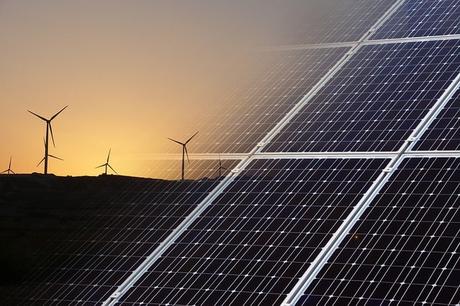Generating electricity from renewable energy sources is not only better for the environment compared to fossil fuels, but it will also be consistently cheaper in just a few years, according to a new report.
According to a cost analysis from the International Renewable Energy Agency (IRENA), the best onshore wind and solar photovoltaic (PV) projects could deliver electricity for $0.03 per kilowatt-hour (kWh) by 2019, much lower than the current cost of power from fossil fuels, which ranges from $0.05 to $0.17 per kWh.

The analysis highlights the dramatic dip in solar and wind prices over the last decade. Onshore wind has fallen by around a quarter since 2010, with solar PV electricity costs falling by 73 percent in that time. Additionally, solar PV costs are expected to halve by 2020.
In the last 12 months alone, the global weighted average costs of onshore wind and solar PV have stood at $0.06 and $0.10 per kWh, respectively. Recent auction results also suggest future projects will significantly undercut these averages—onshore wind is now routinely commissioned for $0.04 per kWh. Additionally, record low prices for solar PV in Abu Dhabi, Chile, Dubai, Mexico, Peru, and Saudi Arabia have made $0.03 kWh (and below) the new benchmark.
IRENA stated in a tweet: “Utility-scale solar PV’s levelised cost of electricity has dropped 73% since 2010 & onshore wind by 23% between 2010 & 2016 #WFES #ADSW”
According to the report, the cost reductions have been driven by a number of factors, including competitive procurement practices, the emergence of a large base of experienced medium-to-large project developers competing for global market opportunities, and continued technological advancements.
“Turning to renewables for new power generation is not simply an environmentally conscious decision, it is now—overwhelmingly—a smart economic one,” Amin continued.
“Governments around the world are recognizing this potential and forging ahead with low-carbon economic agendas underpinned by renewables-based energy systems. We expect the transition to gather further momentum, supporting jobs, growth, improved health, national resilience and climate mitigation around the world in 2018 and beyond.”
The report was released Saturday, the first day of IRENA’s Eighth Assembly in Abu Dhabi, where more than 1,100 representatives of governments from 150 countries met to reaffirm the global renewable energy agenda and to make concrete steps to accelerate the global energy transition.
Here are highlights from the report:
- The global weighted average levelized cost of electricity (LCOE) of utility-scale solar PV has fallen by 73 percent between 2010 and 2017 to $0.10/kWh.
- The average cost of electricity from onshore wind fell by 23 percent between 2010 and 2017. Projects are now routinely commissioned at $0.04/kWh and the global weighted average is around $0.06/kWh.
- By 2019, the best onshore wind and solar PV projects will be delivering electricity for an equivalent of $0.03/kWh, or less. New bioenergy and geothermal projects commissioned in 2017 had global weighted average costs of around $0.07/kWh.
- Record low prices for solar PV in Abu Dhabi, Chile, Dubai, Mexico, Peru and Saudi Arabia have made $0.03 kWh (and below) the new benchmark.
- By 2020, project and auction data suggest that all currently commercialized renewable power generation technologies will be competing, and even undercutting, fossil fuels by generating in the range $0.03 to $0.10/kWh range.
Those auction results were made possible by positive regulatory frameworks, favorable tax laws, low project development costs, and plentiful solar and wind resources, according to IRENA. But just because auctions seem to indicate sinking price targets does not mean recent price records will become the norm. GTM Research solar analyst Benjamin Attia noted in October that prices like those in Saudi Arabia’s auction are likely unsustainable. IRENA, too, suggests that the prices — though encouraging — should be taken with a grain of salt.
“While the validity of comparing LCOE and auction prices for individual projects must be done with caution, the volume of data available and the consistent trends between the two datasets provide some confidence in the overall trend,” reads the report. “The outlook for solar and wind electricity costs to 2020, based on the latest auction and project-level cost data, presages the lowest costs yet.”
The hypothesis will be tested soon. The Abu Dhabi Water & Electricity Authority announced Monday it will invite bidders for its second solar power plant by the middle of 2018, with capacity equal to or greater than its last auction. Abu Dhabi claimed the world-record solar price title just last year. It has now been unseated several times over.
The more renewable energy capacity increases, the further it will lower electrical costs. As it doubles, investment drops by nine percent and electricity generation costs drop by 15 percent. Not only is renewable power benefiting the environment, but in a few years it will become a better economic option for many businesses and residents.

